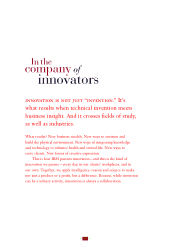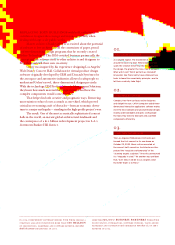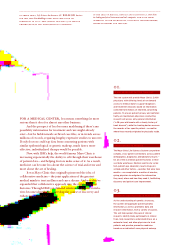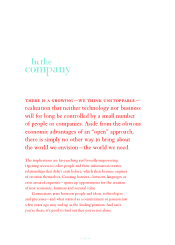IBM 2003 Annual Report Download - page 28
Download and view the complete annual report
Please find page 28 of the 2003 IBM annual report below. You can navigate through the pages in the report by either clicking on the pages listed below, or by using the keyword search tool below to find specific information within the annual report.
26
in academic circles, it’s widely known as the
“traveling salesman problem”: Take a finite number of points and
the cost of travel between each pair of them. Then find the most
cost-effective way to visit all the points and return the traveling
salesman to where he started. But for a leading limousine company
serving thousands of traveling salespeople and other professionals
every day, it was a complex business problem, as well.
When BostonCoach initially asked IBM to install a global-
positioning system, so that its dispatchers could find optimal
routes, it inspired us to see the fleet itself as an organic system.
In the process, we rethought how a limo company (with thousands
of customers, rides and routes on any given day) could become an
on demand business, with continual response and analysis of data
in the search for maximum efficiency.
With the solution developed by IBM, the drivers’ assign-
ments are still made by fleet controllers—real people with years
of experience. But the system now uses an algorithm developed
by IBM researchers to solve the problem of scheduling. By consid-
ering positioning data, business “rules” and even driver pay rates
and FAA schedules, the Fleet Optimization System maps the
location of drivers and customers and suggests to dispatchers
the best matchups.
As a result, while other travel companies have experienced
declines in revenue and customer loyalty, BostonCoach is on target
to achieve a 20 percent increase in productivity and a 10 percent
increase in sales.
01.
NOW SERVING ATLANTA
Despite the name, BostonCoach has operations
in nine major cities, with affiliates in more than
450 other cities globally and with as many as
1,000 to 1,400 rides per day in its largest markets.
Normally, establishing service in a new city would
require BostonCoach to create a new dispatch
center operating 24 hours a day, 7 days a week,
right at startup. With the efficiencies of the
Fleet Optimization System, in 2003 the
company entered an entirely new market—in
Atlanta—by relying completely on its existing
dispatch centers.
02.
BETTER SERVICE WITH BETTER SCHEDULES
BostonCoach leads in the van, limousine and
sedan service industry for on-time pickup, but
leadership used to come at a cost. Before the
system created by IBM’s On Demand Innovation
Services, dispatchers would often turn down
last-minute reservations—or send two cars to
meet a single customer—rather than risk brand-
damaging disappointment. Now, fleet controllers
can accept more business and use cars more
efficiently, with a system that optimizes sched-
ules for three different time scales: daily, every
15 minutes and even several times per minute.
























